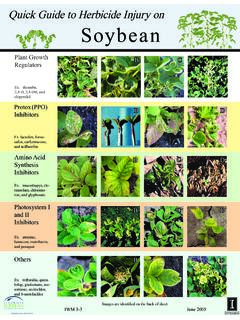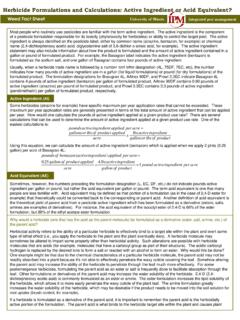Transcription of Family name Common name - University Of Illinois
1 Contents Family name Common name Liliaceae .. Star-of-Bethlehem, Wild garlic, Wild onion .. 2. Poaceae .. Annual bluegrass, Carolina foxtail, Downy brome .. 3. Foxtail barley, Quackgrass .. 4. Asteraceae .. Butterweed..4. Cornflower, Dandelion, Fleabanes ..5. Horseweed, Pineapple-weed, Prickly lettuce ..6. Western salsify ..7. Boraginaceae .. Corn gromwell .. 7. Brassicaceae .. Bushy wallflower .. 7. Field pennycress, Shepherd's-purse, Smallflowered bittercress .. 8. Tansymustard (or flixweed), Virginia pepperweed, Wild mustard .. 14. Yellow rocket .. 15. Campanulaceae .. Venuslookingglass.. 15. Caryophyllacaea .. Common chickweed .. 15. Mouseear chickweed .. 16. Chenopodiaceae .. Kochia .. 16. Geraniaceae.. Carolina geranium .. 16. Lamiaceae .. Henbit, Purple deadnettle .. 17. Onagraceae .. Eveningprimrose .. 17. Plantaginaceae.
2 Plantains .. 18. Polygonaceae .. Broadleaf dock, Curly dock, .. 18. Prostrate knotweed, Wild buckwheat .. 19. Ranunculaceae.. Buttercups .. 19. Mousetail .. 20. Rubiaceae .. Catchweed bedstraw .. 20. Scrophulariaceae .. Common mullein .. 20. Corn speedwell, Purslane speedwell .. 21. Violaceae.. Field pansy.. 21. Taxonomic key Grasses and grasslike plants .. 9. Plants with spines .. 10. Plants with an ocrea .. 10. Plants with square stems .. 10. Plants with milky sap .. 10. Plants with finely dissected leaves .. 11. Plants covered with hair.. 11. Plants that form dense mats .. 12. Plants with a basal rosette .. 12. Guide to herbicides .. 13. Glossary .. 22. Index .. 22. Credits and ordering information .. inside back cover About this guide Using the plant description and photograph can be found. Some plants that have several This guide is intended to serve as taxonomic key distinct features will appear under a practical reference for the identifi- more than one heading in the key.
3 A simple taxonomic key has cation of Common weeds present in For obvious reasons, this guide does been developed to assist in identify- no-till production systems. Various not contain all plant species that may ing Common winter annual and early winter annual, biennial and peren- be encountered in no-till production. spring weeds in no-till fields. Look nial species are usually present in If you need assistance in identifying first for the obvious features of the sufficient populations in early spring a weed, a sample can be submitted weed, such as square stems, whorled to warrant a burndown herbicide through your local University leaves, or the presence of thorns or treatment before planting a summer Outreach and Extension Center to spines. Then refer to the diagrams in row crop. Proper identification is the University Extension Diagnostic the taxonomic key to identify the critical for selecting herbicides and Clinic in Missouri or through similar plant.
4 The key will refer you to the for determining their appropriate programs in other states. page in this guide where a short application rates. Numerous plant species are typi- cally present in no-till production fields in the early spring before herbicide applications. Many of these species are winter annuals, which complete their life cycles before summer crops are planted and thus will not pose a direct produc- tion problem. However, if they are still actively growing and are not controlled, there will be a rapid increase in the weed seedbank and future populations, which could pose problems with nutrient management and rotation to winter annual or perennial crops. Consultants and extension personnel are routinely requested to identify these species and to provide guidance on manage- ment of these fields. Thus, the purpose of this guide is to provide some direction on identification and whether or not it is normally neces- sary to make a herbicide application for a particular species.
5 The weeds presented in the following pages are organized by taxonomic plant Family . The grasses and grasslike plants Liliacaea and Poaceae appear first, followed by the identify a weed, you may follow either of two routes: (1) start with the taxonomic key on pages 9 12 and proceed to the photographs at the page numbers indicated in the key, or (2) start with the photographs and move to the taxonomic key with the help of the thumbnail symbol beside each description. Italicized terms throughout the text are included in the glossary. Field pennycress Star-of-Bethlehem Liliaceae (Ornithogalum umbellatum). Similar in appearance to wild onion and wild garlic, star-of- Bethlehem does not have the charac- teristic odor of onion and garlic. The leaves are grooved and dark green with a prominent white midrib. It is also a bulbous perennial that dies back in late spring to early summer.
6 Wild garlic (Allium vineale). Wild garlic is a bulbous perennial that emerges in the early spring and dies back in late spring. Leaves are hollow, lack hair and have a strong odor. Wild onion (Allium canadense). Wild onion is similar in appearance to wild garlic except that the leaves are flattened and not hollow. Its life cycle is a perennial. 2 early Spring Weeds of No-Till Crop Production Annual bluegrass Poaceae (Poa annua). This clump-type winter annual has characteristic boat- shaped leaf tips. The leaf blades are flat and smooth on both surfaces and have a light green coloration. The ligule is 1 to 2 mm long and membra- nous. The seed head is a small, open, greenish white panicle. It tends to inhabit cool, moist areas and does not tolerate heat. Carolina foxtail (Alopecurus carolinianus). A winter annual, Carolina foxtail is found primarily in moist areas of fallow fields.
7 It has erect stems and flat leaf blades that are 1 to 5 mm wide. A membranous ligule, normally 2 to 3 mm long, tapers to a pointed or rounded tip. The seed head, which appears in April and May, is a single spike similar to that of timothy. Downy brome (Bromus tectorum). and cheat (Bromus secalinus). This winter annual has twisted leaves (2 mm wide) covered with dense, soft hairs on both surfaces. The ligule is a short membrane about 1 mm long. The seed head is a droop- ing green or reddish purple panicle and appears from April to early June. Cheat, a closely related species, is similar in appearance, especially in the seedling stage, but becomes less pubescent than downy brome as it matures. The sheath of both species is closed to near the top of the collar. MU Extension 3. Foxtail barley Poaceae (Hordeum jubatum). Foxtail barley has a bluish green appear- ance.
8 It is a short-lived perennial species with flat blades that are 2 to 5 mm wide. The ligule is a short truncate membrane less than 1. mm long. The cylindrical seed head contains long awns, giving it a squirrel-tail appearance. Foxtail barley tends to be most abundant in poorly drained sites with high pH. Quackgrass (Elytrigia repens). Quackgrass is a peren- nial that produces an extensive rhizome system. The leaf blades are thin, usually ranging from 3 to 6 mm in width. The plant possesses auricles that clasp around the stem. The ligule is membranous and short, less than 1. mm in length. The presence of leaf hair varies on the upper blade surface;. but the lower blade is smooth. The seed head is a long spike. Butterweed Asteraceae (Senecio glabellus). Butterweed is most commonly found in wet areas. It is an annual with smooth and hollow stems.
9 At times there may be hair in the leaf axils, giving it a cobwebby . appearance. The leaves are irregularly and deeply cut to the midrib and lack hair. Lower leaves have petioles while the upper leaves lack petioles. Often, the foliage turns reddish purple after flowering. 4 early Spring Weeds of No-Till Crop Production Cornflower Asteraceae (Centaurea cyanus). Also called bachelor's button, cornflower behaves like a winter annual. It appears to be covered with loose, white hair giving it a cobwebby appearance. The flowers are usually blue-purple in color. Dandelion (Taraxacum officinale). Dandelion is a cool- season perennial that forms a large taproot. Like wild lettuce, it forms a basal rosette of leaves. The leaf margins are very irregular, toothed or wavy with their deep lobes. All parts of the plant contain a milky sap.
10 The flower is large and yellow, and the mature seed head has a puffball . appearance. Fleabanes (Erigeron spp.). Several species of flea- bane are Common to the Midwest. These form a basal rosette of leaves before bolting. They are variable in their life cycles. Some are winter annuals while others behave like perennials or biennials. Flowers have the characteristic daisy appearance. MU Extension 5. Horseweed Asteraceae (Conyza canadensis). Horseweed, also known as marestail, is a winter annual or an early -emerging summer annual plant. It forms a small basal rosette while a seedling. Later, the plant assumes an erect, columnar appearance. The stems and leaves are covered with dense hairs. Leaves lack petioles and tend to be long and narrow. Pineapple-weed (Matricaria matricarioides). Pineapple-weed is an inconspicuous, low- growing annual weed with finely cut, succu- lent, hairless leaves.






